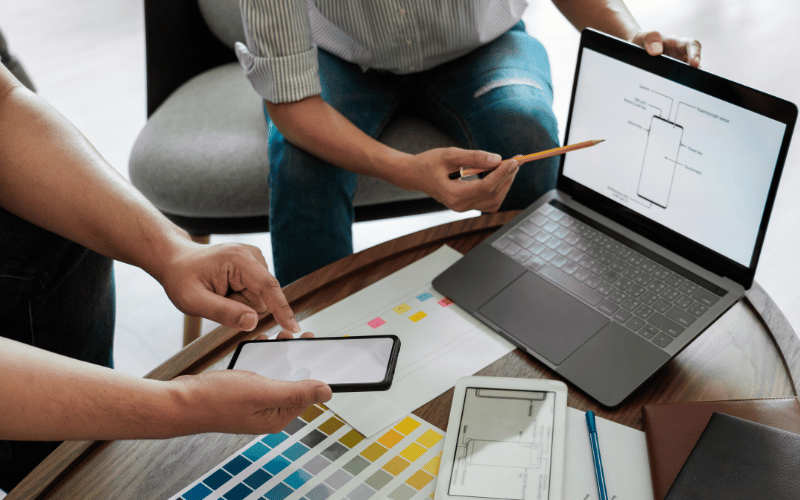So you’ve got a brilliant product idea that’ll revolutionize your industry. However, it seems the users’ needs and wants do not align. Even if you think there is no obvious distinction between the two, using empathy helps to draw a more subtle line between them. This is the advantage of design thinking for product managers.
Design thinking is not just a method; it’s a mindset that leads to transformative results for your business. Now, you might be wondering, “Why is design thinking particularly crucial for me as a product manager?”
It’s difficult to keep up with the newest developments in the product development market. Design thinking brings a human-centered approach to product development. It’s all about putting your users – the real people who will interact with your product – at the heart of the process. By focusing on empathy, collaboration, and iterative learning, you can ensure your product solves real problems for real people.
This blog will cover the core principles and frameworks in design thinking, the various stages involved in the process, and the benefits it offers. First, we must focus on the importance of design thinking for product managers.
Importance of Design Thinking for Product Managers
Design thinking helps you deeply understand user needs and challenges. You can chart a clear innovation path using design thinking which leads to building products that truly make a difference. By understanding user needs and frustrations, you can create products that not only meet their expectations but exceed them.
Using these approaches without expert guidance can be tough. Companies like Codewave provide services that pave the way for SMEs to embrace design thinking with ease.
Core Principles of Design Thinking for Product Managers
Design thinking puts your user at the center of product development by tuning into their needs and frustrations. But what does that look like in practice, especially for you as a product manager?
User Empathy
Empathy isn’t about a fleeting moment of sympathy for your users; it’s about really digging deep into what they experience every day.
- What gets them excited?
- What are the pain points they face with current solutions on the market?
As a product manager, you play a role in reading users’ minds to predict and understand their needs, motivations, and pain points. To do this effectively, you need to engage directly with your users.
You could do this by observing them as they interact with your products or conducting in-depth interviews. However, remember your goal is to collect insights that drive your product strategy, not just check a box.
Collaboration
Talking about your product development process, collaboration is key. Design thinking thrives on diverse perspectives. It brings together people from different backgrounds – marketing, engineering, and design – to brainstorm and build on each other’s ideas. The best ideas often come from a healthy discussion and different viewpoints.
This cross-functional collaboration sparks innovation and helps you avoid blind spots. This is where your leadership as a product manager becomes crucial. You ensure these sessions are productive and focused, yet open enough to encourage out-of-the-box ideas.
Experimentation
This stage is all about turning those bright ideas into strong working prototypes. You will not be aiming for perfection on the first try here, so rapid prototyping is helpful. It will help you learn what works and what doesn’t as quickly as possible.
Design thinking encourages rapid prototyping – building simple, early versions of your product – to get it into users’ hands early and often.
- Create simple prototypes and get them into the hands of your users.
- Watch how they interact with the prototypes, ask for their feedback, and use what you learn to tweak and improve.
Iterative Process
Design thinking is inherently non-linear. It’s not a straight walk from point A to B. Instead, it’s a flexible, iterative process. This allows you to cycle back to previous stages as you learn more and refine your approach. As a product manager, you’ll need to be comfortable with this process as it requires a bit of patience and a lot of resilience.
Design Thinking Stages
You can ensure your product becomes a must-have by focusing on empathy, collaboration, and constant learning. Here are the five essential stages of design thinking that every product manager should master.
Stage 1: Empathize with Users
Design thinking kicks off with empathy. This is where you step into your users’ shoes, but it goes beyond simple observation. You need to interact through interviews, watching their daily routines, and analyzing their data from the interactions.
- What are their needs?
- What are their frustrations?
This stage is all about gathering real, actionable insights. These will help you go deeper than normal assumptions about the user’s experience.
Stage 2: Define the Problem
Once you have knowledge about your users, it’s time to define the problem you’re solving. It’s about what the users need, however, which is usually different from what they say they want. Here, you combine the research to pinpoint user’s needs and pain points.
Pain points are the frustrating parts of the user’s experience where your product can really make a difference. This is where the problem statement comes to life, which is a clear and concise target to focus your team’s energy.
Stage 3: Ideate
You’ve got your team together, you know your users, and you understand their needs. Now you must brainstorm. The goal here is to generate a broad range of ideas—wild, practical, and innovative. Creativity and quantity are key at this stage. The more ideas, the better.
- Generate a wide range of creative solutions.
- Get different teams on the project together and let the ideas fly.
- Collaboration is key as different perspectives can lead to breakthrough solutions you might not have considered on your own.
Stage 4: Prototype
With promising ideas selected, move into prototyping those ideas. Build models, draft sketches, or use digital tools to create prototypes that bring your ideas to life. See what works, and what doesn’t, and gather user feedback.
Design thinking uses rapid prototyping. This means building simple, early versions of your product – such as sketches, mockups, and even cardboard cutouts – to get it into users’ hands early on. This allows you to refine your ideas and iterate quickly based on real-world user experiences.
Stage 5: Test
The testing stage is where you take your prototypes back to the users. Watch how they use them, listen to what they say, and observe their frustrations and their satisfaction. User feedback is gold. It allows you to refine your ideas and improve.
Design thinking is an iterative process. Once you’ve got a prototype in front of users, collected feedback, and analyzed user behavior, you get actionable insights. Use these insights to refine your test product. Don’t be afraid to go back to the drawing board if needed. It’s all about creating a product that truly meets your users’ needs.
Must Read: Behavioral Design Thinking: Understanding why people do what they do, to solve problems
Frameworks and Models in Design Thinking
With various frameworks and models available in design thinking for product managers, using one can be difficult. Dive into these influential design thinking frameworks and models that could reshape how you think about product development.
Stanford d.school’s Five-Stage Model
The Five-Stage Model from Stanford’s d.school is now a gold standard in design thinking. It is a straightforward model that includes the whole creative process, from initial understanding to final testing.
- You start by empathizing with your users.
- Then you define their needs and gather insights.
- You ideate by generating a variety of solutions.
- You turn these ideas into prototypes.
- Finally, you test these solutions with users and refine them based on feedback.
IDEO’s Three-Phase Model
IDEO is a global design company known for pioneering design thinking. It simplifies the process into three broad phases: Inspiration, Ideation, and Implementation.
- During the Inspiration phase, you gather insights and ideas from the world around you, namely from your users’ experiences.
- Ideation involves coming up with ideas and solutions based on your insights.
- Implementation is where these ideas become real, actionable results that you test and bring to the market.
IBM’s Enterprise Design Thinking
IBM’s approach puts a focus on user outcomes. Their framework is built around the core principles of design thinking but tailored to fit the scale and challenges of a large enterprise. Their model promotes teams to remain user-focused at every stage. This way they ensure the developed products are innovative as well as deeply align with user needs and business goals.
Double Diamond Model by UK Design Council
The Double Diamond Model introduces four phases of design thinking: Discover, Define, Develop, and Deliver. The model promotes the idea of exploring an issue more deeply and broadly (divergent thinking). After that, it focused on taking focused action (convergent thinking).
- You start by discovering which user problems exist.
- Then define the actual problem you intend to solve.
- Develop solutions through prototyping, and finally, deliver a tested, refined solution.
Design Sprint
Design Sprint is a five-day process originated by Google Ventures. It answers critical business questions through design, prototyping, and testing ideas with customers. It is a highly structured approach that fast-tracks the design process. It’s useful for rapid problem-solving and is popular among startups and SMEs looking to move quickly.
Balanced Breakthrough Model
This model aims for a balance between desirability, feasibility, and viability—three essential pillars for successful product innovation. It encourages teams to create products that are not only technically and economically feasible but also desired by users. It ensures solutions are practical and sustainable.
Applying Design Thinking in Product Management
Design thinking for product managers is a powerful toolkit that transforms brainstorming sessions into user-centric breakthroughs. So how can product managers embed design thinking into workflows to solve problems creatively and meet business objectives?
Empathy Maps and User Personas
Empathy maps are visual maps that capture your user’s thoughts, feelings, and experiences. Through interviews and observations, you can chart their needs, frustrations, and even their daily routines. This deep dive helps product managers see the world through users’ eyes.
User personas are fictional characters built on real user data. They represent your target audience, allowing you to make informed decisions about features and functionality.
Problem Statements and ‘How Might We’ Questions
Now, it’s time to define the problems you’re solving. Forget vague ideas – a clear and concise problem statement is your guiding light. It pinpoints the core user needs your product must address. A well-built problem statement helps you in ideation by ensuring that everyone on your team knows exactly what user issue they are addressing.
‘How Might We’ (HMW) questions are fantastic for opening up the floor to creative thinking. For example, suppose your problem statement is about users needing a faster way to purchase a product. An HMW question can be, “How might we reduce the steps in our checkout process?”
Prototyping Strategies: Low-fidelity
When it comes to prototyping, starting simple is key. Begin with low-fidelity prototypes—these can be basic sketches or paper models. The beauty of low fidelity is that it helps in rapid iteration. You don’t invest too much time in details that can change based on user feedback.
It allows you to quickly model a solution, test it, learn from it, and improve it. This iterative cycle is crucial in design thinking. It helps you to evolve your prototypes until they effectively solve the user’s problem.
Testing Approaches
Testing is part of an ongoing process of refinement. Focus on small, manageable tests. They must provide specific insights into how real users interact with your prototype. The goal is to gather actionable data like ‘What works?’, ‘What doesn’t?’, or ‘Where do users get stuck?’
Design Thinking for Problem-Solving and Meeting Business Objectives
The power of design thinking lies in its ability to merge product development with both user needs and business goals. This approach helps solve complex problems creatively. It also aids in ensuring that the solutions are workable in the market. As a product manager, you can develop innovative, user-centered, and successful projects.
Benefits of Design Thinking in Product Management
User-Centric Approach to Product Development: Design thinking is about stepping back and asking, “Who are we really building this for?” By engaging directly with your target audience early and often, you ensure that your product developments are always aligned with what your users genuinely want and need.
Creative Problem-Solving and Innovation: Design thinking allows your team to explore innovative solutions. Through brainstorming sessions, ideation workshops, and creative sprints, your team can uncover unique solutions.
Iterative and Agile Methodology: In design thinking, you don’t just design once and hope for the best—you continually refine and adjust. After initial prototypes, you test, gather feedback, and iterate. It ensures when your product finally hits the market, it’s refined through real-world feedback, making it all the more likely to succeed.
Empathy and Emotional Connection: A massive advantage of design thinking is the empathy it builds towards users. Empathy leads to products that resonate more deeply with users, creating a loyal customer base that feels understood and valued.
Collaboration and Cross-Functional: Design thinking brings together different opinions. This collaboration ensures that your product benefits from a holistic view. It aligns all teams towards a common goal and smoothes out any potential errors from concept to launch.
Faster Time-to-Market: Design thinking aligns closely with agile development practices. It can speed up your product’s journey from concept to market. With clear focus, streamlined development stages, and continual feedback loops, you’re able to move faster.
Examples of Design Thinking in Action
Airbnb: Airbnb transformed the hospitality industry by focusing on understanding user needs. Through research, they discovered travelers needed authentic experiences and hosts wanted a safe, user-friendly platform. Their design thinking approach led to features like verified profiles, reviews, and secure payment systems.
Slack: Slack’s design thinking process revolves around constant communication with its user base. They can identify pain points (like email overload) and develop innovative solutions (like channels and integrations).
Intuit: TurboTax, a product-driven by customer-centric design thinking, held extensive research to understand user anxieties and frustrations. This led to features like guided interviews, step-by-step instructions, and even a “Where My Refund” tracker. By focusing on user empathy and iteration, TurboTax made a tedious task more manageable.
Conclusion
The answer for design thinking for product managers is a human-centered approach to innovation. By focusing on empathy, collaboration, and iterative learning, design thinking ensures that your product not only addresses but also anticipates the needs of your users.
Codewave is at the forefront of design-led tech development, specifically catering to the unique needs of SMEs. Our specialization lies in new product development and scalable technology solutions across the USA, GCC, India, Canada, and Australia. Codewave’s approach is deeply rooted in design thinking principles.
Contact Codewave today and unlock the power of design thinking for your next big product!
Codewave is a design thinking led digital transformation company enabling organisations with playful innovation using AI & ML, IoT & Edge, AR, VR, Cloud, Blockchain, and Data.







